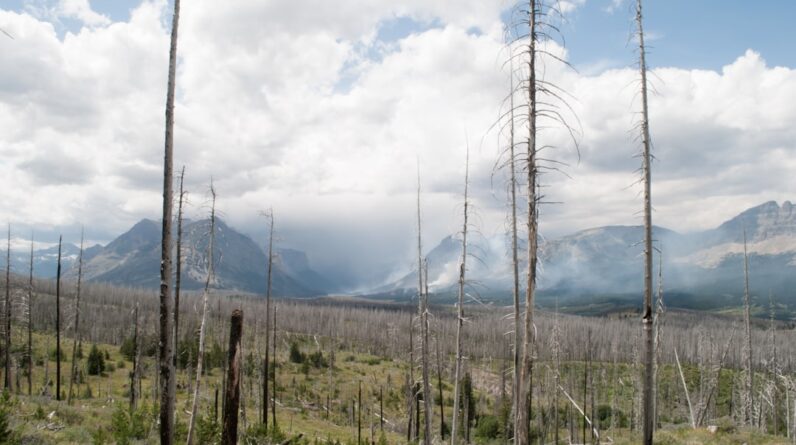
Deforestation is one of the most pressing environmental issues of our time, and its impact on climate change is both profound and alarming. When you consider that forests act as carbon sinks, absorbing carbon dioxide from the atmosphere, the removal of these vital ecosystems releases vast amounts of greenhouse gases. This process not only exacerbates global warming but also disrupts the delicate balance of our climate systems.
As you witness the increasing frequency of extreme weather events, it becomes clear that deforestation is a significant contributor to these changes, leading to a cascade of environmental consequences that affect every corner of the globe. Moreover, the loss of trees means a reduction in the natural processes that regulate temperature and precipitation patterns. You may have noticed that regions once characterized by stable climates are now experiencing erratic weather, which can be traced back to deforestation.
The interplay between trees and climate is intricate; trees not only absorb carbon but also release water vapor through transpiration, which helps to maintain humidity levels. When forests are cleared, this cycle is disrupted, leading to drier conditions and altered rainfall patterns. The implications for agriculture, water supply, and overall human health are staggering, making it imperative for you to understand the urgency of addressing deforestation in the context of climate change.
Key Takeaways
- Deforestation significantly contributes to climate change by releasing carbon dioxide into the atmosphere.
- Loss of biodiversity and ecosystem services is a direct result of deforestation, impacting the balance of natural systems.
- Natural disasters such as floods and landslides are more likely to occur in deforested areas due to reduced tree cover.
- Decline in soil fertility and agricultural productivity is a consequence of deforestation, affecting food security.
- Indigenous communities are displaced and traditional knowledge is lost as a result of deforestation, leading to social and cultural impacts.
The Loss of Biodiversity and Ecosystem Services
As you delve deeper into the consequences of deforestation, you cannot overlook the staggering loss of biodiversity that accompanies it. Forests are home to approximately 80% of the world’s terrestrial species, and when these habitats are destroyed, countless plants and animals face extinction. This loss is not merely a tragedy for wildlife; it has far-reaching implications for human well-being.
Biodiversity is essential for ecosystem services such as pollination, pest control, and nutrient cycling, all of which are critical for food production and maintaining healthy environments. You may find it alarming that the extinction of a single species can trigger a domino effect within an ecosystem. For instance, the decline of pollinators like bees due to habitat loss can lead to reduced crop yields and diminished food security.
Furthermore, forests play a crucial role in regulating water cycles and maintaining soil health. When you consider that deforestation disrupts these services, it becomes evident that the loss of biodiversity is not just an environmental issue; it is a direct threat to human survival and prosperity. Protecting forests is essential not only for preserving wildlife but also for ensuring that ecosystems continue to function effectively for generations to come.
Increased Risk of Natural Disasters

The relationship between deforestation and natural disasters is another critical aspect that demands your attention. As forests are cleared, the land becomes more susceptible to erosion, flooding, and landslides. You may have seen news reports highlighting devastating floods or mudslides in areas where deforestation has occurred; these events are often exacerbated by the loss of trees that would otherwise stabilize the soil and absorb excess rainfall.
The consequences can be catastrophic, leading to loss of life, destruction of property, and long-term damage to local economies. Additionally, deforestation can contribute to the intensity of wildfires. In regions where forests have been cleared or degraded, dry conditions can lead to an increased risk of fires spreading uncontrollably.
You might recall recent wildfires that have ravaged landscapes and communities alike; these disasters are often linked to poor land management practices and deforestation. The cycle of destruction continues as fires further degrade the land, making it even more vulnerable to future disasters. Understanding this connection underscores the urgent need for sustainable land management practices that prioritize forest conservation.
Decline in Soil Fertility and Agricultural Productivity
The impact of deforestation extends beyond immediate environmental concerns; it also poses significant challenges for agriculture and food security. When you clear forests for agricultural purposes, you disrupt the natural balance of nutrients in the soil. Trees play a vital role in maintaining soil fertility by contributing organic matter through leaf litter and root systems.
Without this natural input, soils can become depleted over time, leading to reduced agricultural productivity. You may have noticed that many farmers struggle with declining yields in areas where deforestation has occurred. This decline can be attributed to soil erosion, nutrient loss, and increased vulnerability to pests and diseases.
As you consider the global population’s growing demand for food, it becomes clear that sustainable agricultural practices must be prioritized alongside forest conservation efforts. By recognizing the interconnectedness of forests and agriculture, you can appreciate the importance of maintaining healthy ecosystems for ensuring food security in the future.
Displacement of Indigenous Communities and Loss of Traditional Knowledge
The social implications of deforestation are equally significant, particularly concerning indigenous communities who rely on forests for their livelihoods and cultural identity. When you think about deforestation, it’s essential to recognize that it often leads to the displacement of these communities, stripping them of their ancestral lands and traditional ways of life. This loss is not just physical; it also erodes cultural heritage and traditional knowledge that has been passed down through generations.
Indigenous peoples possess invaluable insights into sustainable land management practices that have been honed over centuries. You may find it disheartening that as their lands are cleared for agriculture or development, this knowledge is at risk of being lost forever. The displacement of these communities not only affects their immediate well-being but also diminishes global efforts to combat climate change and promote biodiversity conservation.
By advocating for the rights of indigenous peoples and recognizing their role as stewards of the land, you can contribute to a more equitable approach to forest management.
Economic and Social Impacts of Deforestation

The economic ramifications of deforestation are complex and multifaceted. While some may argue that clearing forests for agriculture or logging can lead to short-term economic gains, the long-term consequences often tell a different story. You might consider how deforestation can lead to soil degradation, reduced agricultural productivity, and increased vulnerability to natural disasters—all factors that ultimately undermine economic stability in affected regions.
Moreover, the social impacts are equally concerning. Communities dependent on forests for their livelihoods face uncertainty as their resources dwindle. You may have seen firsthand how deforestation can lead to increased poverty rates and social unrest as people struggle to adapt to changing circumstances.
The loss of forest resources can exacerbate inequalities within societies, particularly affecting marginalized groups who rely heavily on these ecosystems for survival. Recognizing these economic and social dimensions is crucial for developing comprehensive strategies that address both environmental sustainability and community well-being.
Efforts and Initiatives to Combat Deforestation
In response to the alarming rates of deforestation, various efforts and initiatives have emerged globally aimed at reversing this trend. You may have heard about reforestation projects that seek to restore degraded lands by planting trees and rehabilitating ecosystems. These initiatives not only help sequester carbon but also provide habitats for wildlife and improve local air quality.
Additionally, many organizations are working towards promoting sustainable forestry practices that balance economic needs with environmental conservation. International agreements such as the Paris Agreement also play a vital role in addressing deforestation on a global scale. By committing nations to reduce greenhouse gas emissions and protect forests, these agreements create a framework for collaborative action against climate change.
You might find it encouraging that grassroots movements are gaining momentum as communities come together to advocate for sustainable land use practices and protect their local environments. These collective efforts highlight the importance of collaboration across sectors—governments, businesses, NGOs, and local communities—to create lasting change.
The Urgent Need for Sustainable Forest Management and Conservation
As you reflect on the myriad impacts of deforestation, it becomes increasingly clear that sustainable forest management and conservation are not just options; they are necessities for our planet’s future. You have a role to play in advocating for policies that prioritize forest preservation while supporting local communities’ needs. Sustainable practices can help ensure that forests continue to provide essential ecosystem services while allowing for responsible economic development.
Moreover, raising awareness about the importance of forests in combating climate change is crucial for mobilizing action at all levels—individuals, communities, businesses, and governments alike. You can contribute by supporting organizations dedicated to reforestation efforts or by making conscious choices in your consumption habits that prioritize sustainably sourced products. By understanding the interconnectedness of our actions with global environmental health, you can be part of a movement toward a more sustainable future where forests thrive alongside human communities.
In conclusion, addressing deforestation requires a multifaceted approach that considers its environmental, social, and economic dimensions. As you engage with this critical issue, remember that every action counts—whether it’s advocating for policy changes or supporting sustainable practices in your daily life. The time to act is now; our planet’s health depends on it.
When forests are destroyed, the consequences are far-reaching and devastating. Not only does deforestation contribute to climate change and loss of biodiversity, but it also sets off a terrifying feedback loop that can be difficult to break. One way to combat this destructive cycle is through reforestation efforts. By planting trees and restoring forests, we can help mitigate the impacts of deforestation and create a healthier environment for all living beings. To learn more about how reforestation can help the environment, check out this article on How Does Reforestation Help the Environment.
FAQs
What is deforestation?
Deforestation is the process of clearing or removing trees and forests from a particular area, often for the purpose of making the land available for other uses such as agriculture, urban development, or logging.
What are the consequences of deforestation?
Deforestation can lead to a range of negative consequences, including loss of biodiversity, disruption of ecosystems, soil erosion, increased greenhouse gas emissions, and changes in local and global climate patterns.
What is the feedback loop of deforestation?
The feedback loop of deforestation refers to the cycle in which the removal of trees and forests leads to further negative impacts on the environment, which in turn exacerbates the original problem. For example, deforestation can lead to soil degradation, which reduces the ability of the land to support new tree growth, further accelerating the loss of forests.
How does deforestation contribute to climate change?
Deforestation contributes to climate change by releasing stored carbon dioxide into the atmosphere, reducing the capacity of forests to absorb carbon dioxide, and altering local and global climate patterns.
What are some solutions to address deforestation and its feedback loop?
Solutions to address deforestation and its feedback loop include sustainable forest management, reforestation and afforestation efforts, conservation of existing forests, and policies and initiatives aimed at reducing the drivers of deforestation such as agricultural expansion and logging.





